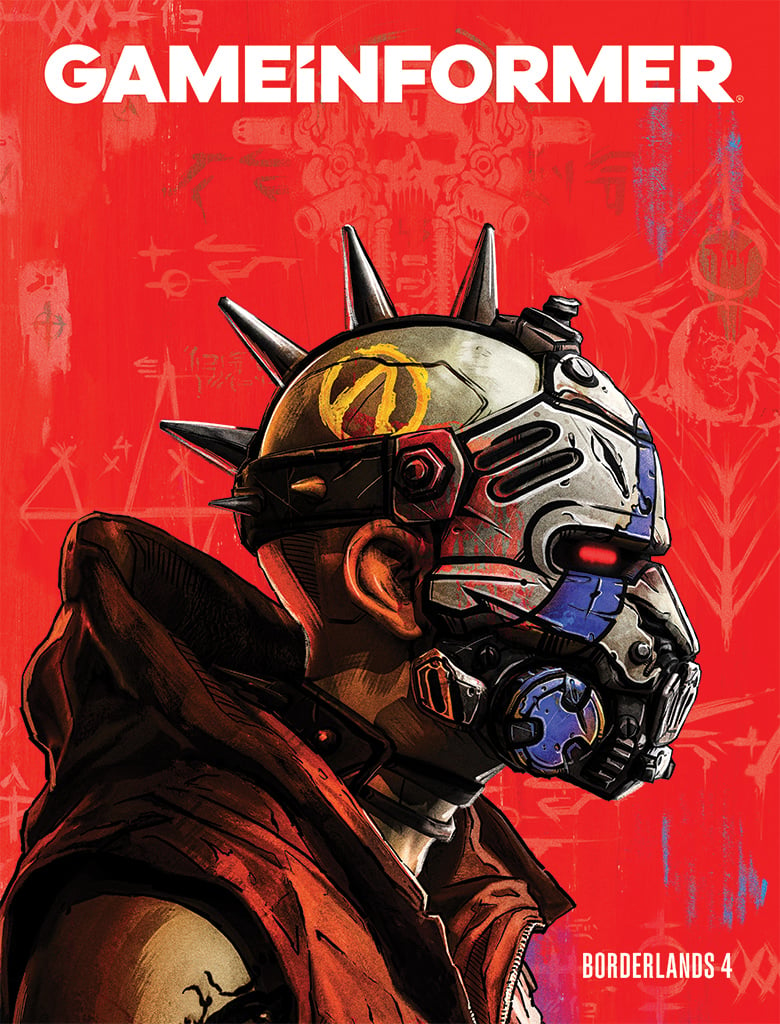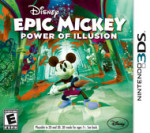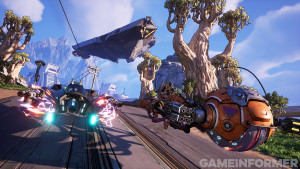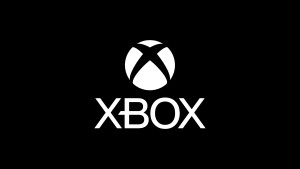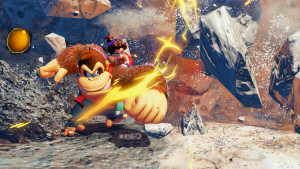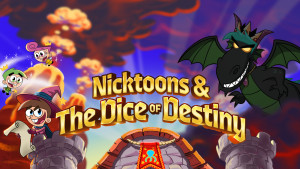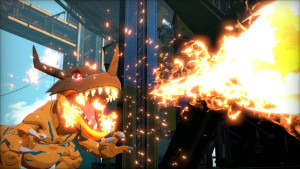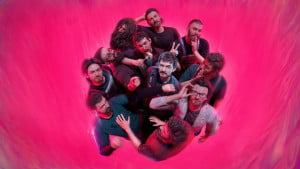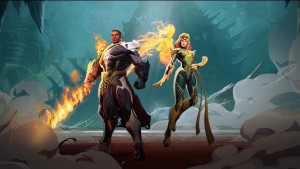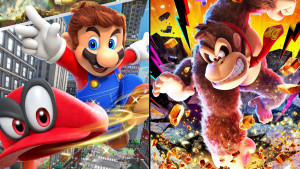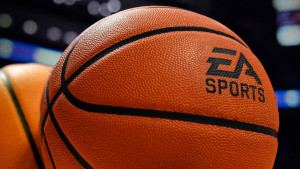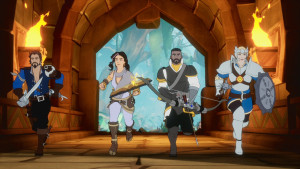Borderlands 4 debut issue is already available for Digital subscriptions. Subscribe Now!
Epic Mickey: Power of Illusion

We had the chance to chat with Peter Ong, co-founder of DreamRift and creative director of Epic Mickey: Power of Illusion. The promising new 2D Mickey game is both a spiritual successor to 16-bit Sega Genesis game Castle of Illusion and fits into the Wasteland universe of Epic Mickey. We picked Peter’s brain about the game’s touch screen-enhanced painting mechanic, sidequests, and his personal love for Castle of Illusion.
How did DreamRift get involved with development of Power of Illusion?
The beginning of the story would be that DreamRift had finished making Monster Tale on the Nintendo DS and rolling off of that we began to prototype what our next game would be. We came up with a central mechanic that we were pretty excited about and we were originally pitching it around as a new IP. What ended up happening along the line was we pitched it to Disney through our point of contact there who we already happened to have a really great relationship with, because we had originally discussed Monster Tale with them as a potential publisher. Disney had really liked the game and had been really excited about it but for various reasons it didn’t end up working out and we ended up going with Majesco. But the whole time that relationship remained strong and both parties remained interested in working with each other if we could ever make that happen. The next step was when we showed them our new game they were excited by the central mechanic, but they also let us know they were interested in bringing the Epic Mickey franchise to the 3DS. We knew that rolling off as a specialized DS developer, we knew that the 3DS would be our main console that we would focus on for development and that’s what we would be developing our new game for. And it just so happened that there were a lot of common design elements with our original pitch design-wise that merged with the idea of what we would have done with Epic Mickey on the 3DS anyway. It was kind of serendipitous because if you had asked us to come up with the design for what we would do to bring Epic Mickey to the 3DS, it would have been about 90 percent the same as the gameplay design for the game we were already making. So it was really easy to roll into talking with Warren Spector and our contacts initially how we already had this really great head start that was surprisingly adaptable as if it was meant to be.
In addition to that, when we first looked at Disney, one of the things that was the most enticing to us was one of the first things that they told us was that in their interest of bringing Epic Mickey to the 3DS there were a couple things they already knew that they wanted. The first was that they wanted it to be its own stand-alone experience and not a direct port of the game. They wanted it to be something original that could stand on its own and give people another experience within the Epic Mickey universe. Secondly, Disney conveyed that they came to us because their number one priority above all with the game is to achieve the highest standard of quality possible.
It wasn’t lost on us that we were a smaller developer that had just gotten started. There were other, more established developers at the time, but what was really encouraging to us and what really excited us about working with Disney, was the acknowledgment on their part that the highest priority to them was the quality of the game experience. We wouldn’t have it any other way, but to focus on that really fits with our company philosophy. It was surprisingly easy for everything to come together. I remember it seemed like things were just working out. The first time I talked to Warren Spector, I think within 30 minutes of speaking he basically told me that he was sold. It’s been really easy since the very beginning.
Can you tell me more about the central painting gameplay mechanic? I understand Mickey can paint objects like a cannon into existence by using the 3DS’ touchscreen to trace them.
You’re graded on your performance based on how well you’re able to trace the object. There are essentially multiple grades of varying reward. For each of these grades that you’re assigned at the end of having painted this cannon, the outcome once the cannon manifests on the gameplay screen on the top screen will be different based on the grade. For example, visually, if you got the worst grade on the cannon then it will materialize and look less substantial. If you get the highest grade, the cannon will have special effects and sparkles around it that will convey it’s a special version of the cannon. So you have those visual differences that will let you know how well you’ve done in addition to the grade that is directly assigned to it after completing it on the bottom screen. But on the top screen it also manifests with different visuals according to how you scored. The final part of that is the actual functional difference to the object which is also corresponding to the grade you attained.
To elaborate on the cannon, in the level they periodically fire these cannon balls that can damage things. When you get the worst score drawing the cannon, the balls being fired from this cannon have a Jolly Roger symbol on them because these cannons exist in Captain Hook’s ship level, which is called the Jolly Roger, with the classic skull and crossbones icon. Because it’s the worst version of this cannon, not only does the cannon ball look different and in addition, the cannon ball only hurts Mickey. It doesn’t affect enemies. Now if you get a middle-grade cannon you have a different-looking cannon and the cannon balls function differently. The cannon ball can damage both Mickey and other characters as sort of a neutral-state cannon. If you score an absolutely perfect score the cannon ball will have a Mickey symbol instead of a Captain Hook symbol which conveys it’s something you own by painting it so well. The property of the cannon ball will only damage enemies. In that case, with it being the highest grade, it actually does nothing but help you.
Can you explain how you get the opportunity to paint an object into existence?
The bottom screen has this alternate, sketchy representation of what you’re playing on the top screen so you can make out the important parts of the environment you interact with in the bottom screen with a 1-to-1 relationship scrolling by with the top screen. It’s sort of an alternate view to the top screen. It looks a bit different and simplified. But the key to that is that as you’re walking across the top screen you see the corresponding environment on the bottom screen and see outlines of objects that signify objects that don’t currently exist on the top screen. The key is to that, is that this indicates the sorts of objects that you can then touch with the stylus in order to engage in the painting activity. Once you touch one of those objects, the bottom screen takes focus and it becomes a dedicated painting game momentarily where the user engages in the painting activity and is graded on their performance upon completing the object whereby the focus switches back to the top screen and you see the object cross from the bottom screen into the top screen that’s now been fully painted.

Will this game feature more traditional platforming akin to the old 16-bit Mickey games, or will it have some Metroid-style backtracking and exploration like in Monster Tale?
With this game the approach is more homage to the original level structure of Castle of Illusion, more so than Monster Tale I would say. That being said, I think it’s a bit more elaborate than the Castle of Illusion game. Each level you play will instead of being a maze-like Metroidvania layout will be sort of a straight-forward Mario-type progression.
Will there be sidequests in Power of Illusion?
There are a lot of optional and secret places in these levels which offer a bit more non-linearity than a standard platforming level. One of the many things you can get by taking it upon yourself to explore these levels and by using the paint thinner mechanic or more nuanced ways to access these optional areas is you can rescue characters. In a nutshell, one of the major features of the game’s story is that there’s a cast of misplaced characters that have manifested within the Castle of Illusion as illusions. For most purposes, they walk, talk, and look exactly like the real thing, being illusions that are cast by the castle. Once in awhile if you’re an attentive player you’ll notice that there are characters that are trapped within those levels. Generally, there’s some sort of trick to getting over to those characters and freeing them. Once you do get to rescue that character they move over to a different part of the castle that is under Mickey’s control called The Fortress. This is sort of a safe haven for toons to go once Mickey has freed them from the clutches of the evil illusions. Once they’re in The Fortress you can visit those characters’ rooms because they take residence there, which grows dynamically depending on the characters you rescue and the quests you perform based on talking to those characters and doing things for them.
One of the things that gets asked of you to do, is Scrooge McDuck offers one of his many quests up to you. He lets you know that he’s lost his number one dime and gives you a general hint where you can find it, which not only offers an incentive to visit and explore levels and areas that you might have missed before, but also a lot times quests will also be in levels you’ve never been to before. Just like you can find secret rescuable characters within levels you can also find Scrooge McDuck’s number-one dime, as one example. Once you’ve done that and you come back to visit Scrooge in The Fortress, he will reward you directly. In fact, the sidequest might actually give him what he needs to modify his room, which is a big part of this game. Characters in The Fortress, depending on how Mickey interacts with them, will actually progress the rooms that these characters move into in the fortress. When the characters first move into The Fortress they move into a room and it’s a really plain, unaltered castle chamber. Based on the things you do for that character you enable them to progress their room towards something that’s more elaborate stage by stage. If you’re able to completely max out all the things you could possibly do with that character, by the end the state of their room is that it’s completely reflective of that character or a specific scene.
What type of rewards can players look forward to for revisiting stages and completing sidequests?
There are a huge amount of rewards that are up for grabs in The Fortress and it’s a surprise each time. I’ll just give you one example, which is this game feature called sketches. The idea with sketches is that there are objects already within levels that you are able to paint. If you see something on the bottom screen you can paint it onto the top. The difference with sketches is that these are objects you bring in and decide where to place them. The way you acquire them oftentimes is as a reward for doing something for a character or helping them progress their room to a certain degree. Because sketches allow Mickey to do things he couldn’t do before, the sketches can be tied into allowing you to access parts of levels you couldn’t before. It all kind of propagates on itself. For example, you need to find a certain character in order to get them into The Fortress, but as soon as you rescue that character they have a quest for you to perform, and once you finish that quest the character will award you with a sketch that you can then use to get to places before that will let you find characters that would have never been accessible before.
So there is a little bit of that Metroid-style gameplay in there.
Yeah, there’s a touch of that.
Those 16-bit Mickey games were pretty tough. How will Power of Illusion compare in terms of difficulty?
We have our own philosophies on difficulty that we believe in. We don’t really think of our games in relation to other games out there when we’re paying homage to them. We try to make games that have a difficulty that feels right to us. I can’t really speak with respect to how it factors in difficulty-wise compared to other games. I think that’s a highly subjective thing. All we try to do is hit our idea of fairness within a game.
You’ve said previously that with Monster Tale it was difficult finding a publisher willing to support a new IP so late in the DSs lifespan. What is like doing the exact opposite -- developing for an existing series on a piece of new hardware?
It was extremely exciting because we’re really into embracing new experiences. Being new was part of the charm. Monster Tale took a little longer to get green-lit than we would’ve wanted, but thanks to Majesco, it ended up coming out and apparently people enjoyed it. Looking back we wouldn’t have traded that experience for anything. Looking forward we’re excited about the way this opportunity is different. I think working with one of the biggest characters of all time, Mickey Mouse, has us excited about being able to reach the widest audience possible.
Moving onto the idea of how this is an existing, enormous, beloved IP that is wrapped into this game that we weren’t dealing with before – Monster Tale was an original IP that we owned and developed – I think first of all that it’s an enormous honor and privilege to work with this cast of characters and universe. Even that alone would have been earth-shattering enough to make us happy to make this game, but then at the same time if you look at our past games, things like Monster Tale which is something we obviously prided ourselves with creating an original universe and character from scratch, the studio is actually really interested in that, but at the same time we always knew it would take something special to make or move for our first time to working with an existing IP. This happened to be this special opportunity. As I mentioned earlier, we didn’t have to sacrifice anything in terms of the gameplay design that we were interested in exploring next. By some happy coincidence what we ended up falling into somehow happened to be an IP that not only worked already with the type of game that we were experimenting with, but in fact it’s one of those rare cases where it actually enhances the gameplay dynamic that you’re looking into exploring – which is inviting the player to participate in actively creating art with a paintbrush. One of the first things that was definitely not lost on us in approaching this game opportunity was the fact that when you’re empowering someone to engage in the process of creation of visuals with a paintbrush, it’s much more powerful and much more intimate to the user to allow them to experience creating something they know and love rather than some random object that they have no association or attachment to. With Disney’s amazing library of creative works it’s just an amazing match that maximizes that pay-off people get when people paint something.
Would DreamRift consider putting Power of Illusion on other platforms?
I’d say DreamRift is definitely excited about that possibility. We have to talk with Disney and see how things go from there, but we think this game would be great on other platforms. Things would have to be changed given the 3DS’ specializations because we’ve made a concerted effort to make a game that specific to the hardware with the dual screens and stylus, etc. I think I lot of the main principles can be adapted to make a game that is best suited to each individual platform.
Castle of Illusion had some terrific, catchy 16-bit tracks, and Epic Mickey had a wonderful orchestrated soundtrack. What direction will Power of Illusion be taking with these predecessors in mind?
I think the answer is you’re going to get a new combination or approach that didn’t exist in either one of those games where it’s basically what we’re taking for inspiration is a little of both. We absolutely adore the soundtrack from the original game. It’s one of the reasons why we jumped at the chance and even brought up the idea in the first place to tie this game to the Castle of Illusion. We’re really excited about the music. Our approach is to try to get players to draw relation to the sort of approach to the music from the original games, while at the same time putting our same spin on it.
Can you name any composers yet?
I can’t at this time, my apologies.
It sounds like Castle of Illusion has a special place in your heart. Tell me about your experience with the game.
I was a young boy when it first came out and it was one of the first games I absolutely loved to the point that I became obsessed with it. I would have to beat it every day over the span of at least a year of my childhood. It’s just one of things that when you’re a kid just gets drilled into your brain. I just absolutely fixated on it. Everything from each pixel of a character to Mickey’s hypnotic idle animation where he sort of sways his hips back and forth and the way he jumps and the sound it makes when he bops his head on the ceiling. I also loved the way that the backgrounds coalesced with the music altogether. All of that was incredibly formative to me as a child. I never dreamed I would even work in games, but somehow it’s happened and with that being one of the biggest experiences of my childhood, I try to analyze and go back to that game and look at it every time I work on a new project and see what I can glean from it in terms of principles that can somehow be abstracted and materialized differently into the projects that I’m working on.
